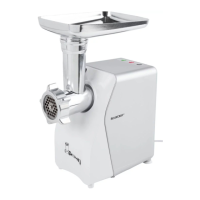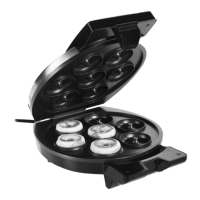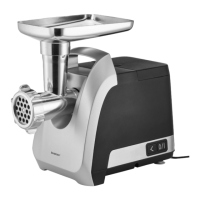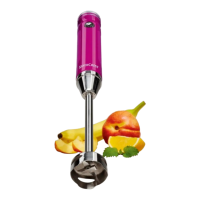8
GB
Therefore, many items of food that have
been dehydrated have an intensive aroma.
Due to the extracted water, dehydrated food
is especially light in weight and can be
stored and transported without cooling or
special packaging.
The dehydrated food can be eaten in dried
form (e.g. as dried fruit), or it may be further
processed after having been soaked (e.g.
mushrooms) or added when cooking (e.g.
herbs).
6.2 Basic functioning of the
food dehydrator
Your food dehydrator draws fresh air through
the ventilation slots|6 on the underside and
heats it up. The warm, dry air flows through
the food dehydrator trays|2/3 from the bot-
tom to the top. Therefore it is important ...
… not to overload the food dehydrator
trays,
… not to cover the mesh screens of the
food dehydrator trays and
… to ensure free ventilation all around.
The warm, dry air flow provides gentle dry-
ing, which varies in time depending on the
water content of the food and the thickness
of the pieces. As an orientation, you can
find temperatures and reference values re-
garding the drying times in chapter "Food
tables" on page 9.
6.3 Selection and prepara-
tion of the food
In order to achieve good quality and dura-
bility, a careful selection and preparation of
the food is decisive. Therefore, you will find
some tips in the following.
• The food should be fresh. Ripe fruit and
vegetables have more flavour. However,
the food should not be overripe.
• If possible, use food of perfect quality.
Select, for instance, fruit without blem-
ishes or bruises and without spoiled
spots. Where required, cut spoiled parts
generously out.
• Clean the food thoroughly and observe
the rules of kitchen hygiene carefully.
Work, for instance, with clean hands
and kitchen utensils.
• When cutting, take into account that the
food will shrink during dehydration.
Therefore, do not cut the pieces too
small.
• Cut the food into pieces of uniform size
and shape to ensure that all pieces dry
evenly.
• Dehydrate the food immediately after
preparation.
Fruit
• The removal of the pips from stone fruit
(e.g. cherries, plums, apricots) is easier
when these are first dried as a whole for
approx. two thirds of the drying time
and only then the stones are removed.
• With fruit turning brown easily (e.g. ap-
ples) the cut surfaces can be dipped slight-
ly in lemon juice before dehydrating.
• With the cut surface upwards, place the
unpeeled fruit onto the food dehydrator
trays|2/3.
Vegetables
• Rub the mushrooms with a damp cloth.
• Wash vegetables thoroughly.
• Prior to the dehydration, vegetables
should be blanched briefly.
Herbs
• Dehydrate herbs in whole with their
stems.
• Rinse herbs and shake them dry thor-
oughly.
• Herbs should be dehydrated at low tem-
peratures and not for an extended peri-
od of time. Otherwise they lose their
flavour.

